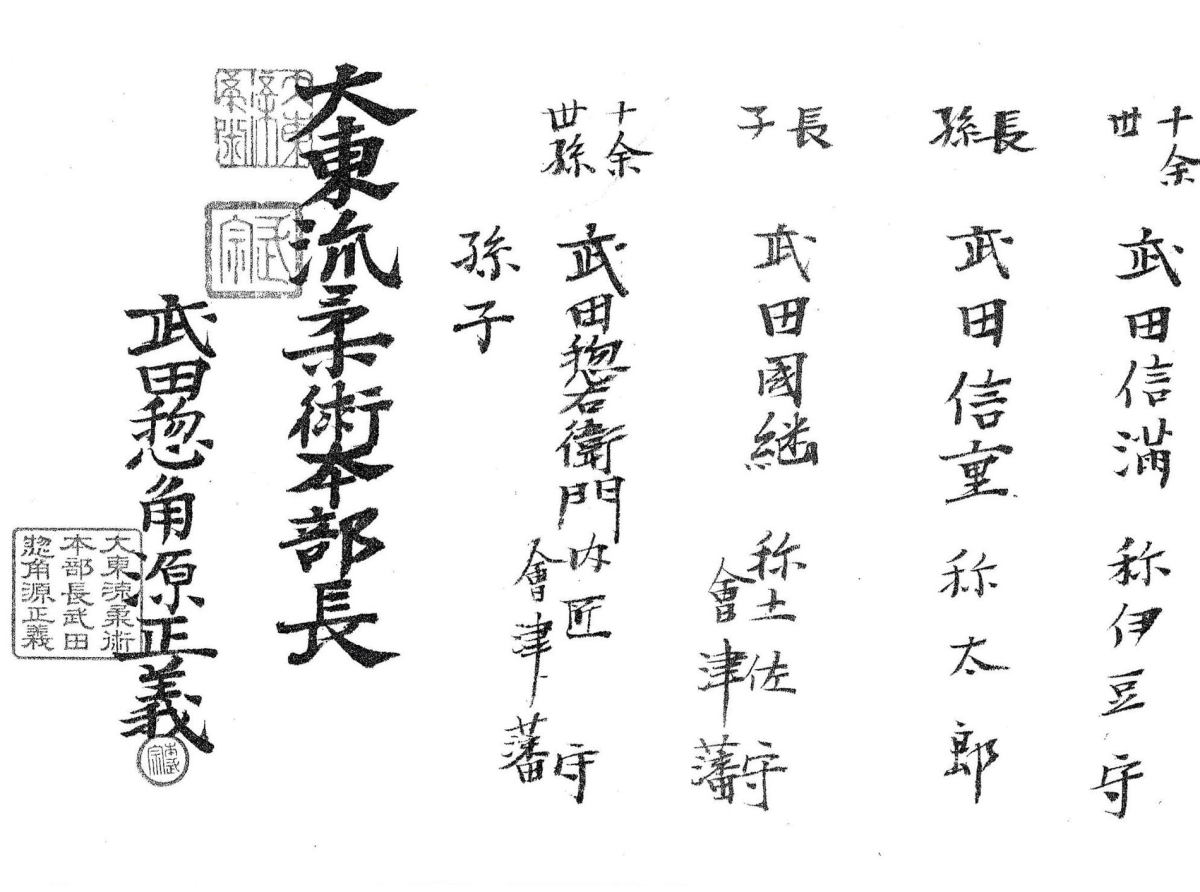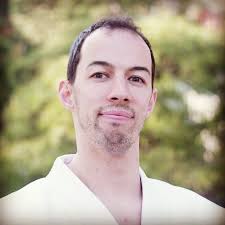Koryu scrolls are quite consistent in their format and the last section usually consists in the lineage of the school they are issued from, demonstrating the continuity and authenticity of the transmission. Daito-ryu scrolls are no exceptions. As a student of Takeda Sokaku, Ueshiba Morihei received and handed out Daito-ryu scrolls to his students before the war, but also after the war, albeit with slight modifications. Consequently, the study of these scrolls is of great interest from an Aikido perspective too. In this article, we are going to investigate the lineage described in all Daito-ryu scrolls and highlight some of the modifications that were made over time. We will study the origin story of Daito-ryu as told by Sokaku himself and how it was reinterpreted in the Aikido circles in the later years.
Before jumping into the topic, let us summarize a few basic pieces of information about Takeda Sokaku’s life that will help us to put the findings in context. Based on the Eimeiroku records, there are only two people whom Sokaku referred to as masters during his life; Shibuya Toma and Hoshina Chikanori.
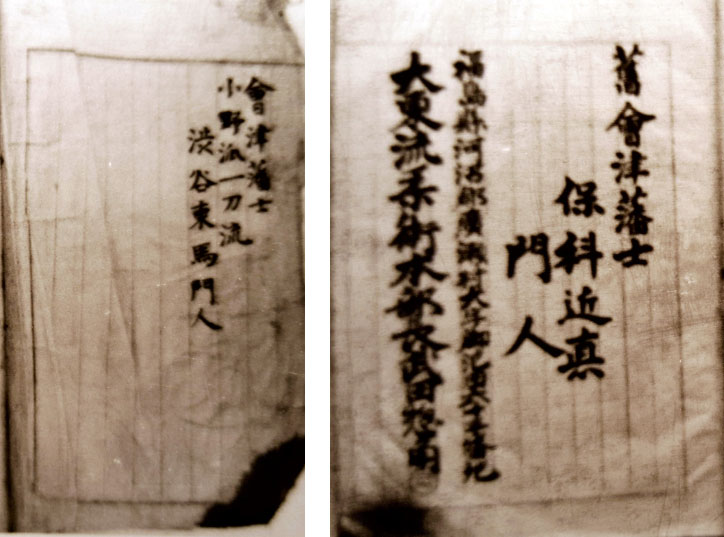 Pages from Sokaku’s Eimeiroku introducing Sokaku as a “student of Aizu samurai Shibuya Toma of Onoha Itto-ryu” on the left and as a “student of former Aizu samurai Hoshina Chikanori” on the right. Note that Hoshina’s martial discipline is not mentioned. Sokaku’s title is written as Director of Daito-ryu Jujutsu Headquarter (大東流柔術本部長, Daito-ryu Jujutsu Hombu-cho)
Pages from Sokaku’s Eimeiroku introducing Sokaku as a “student of Aizu samurai Shibuya Toma of Onoha Itto-ryu” on the left and as a “student of former Aizu samurai Hoshina Chikanori” on the right. Note that Hoshina’s martial discipline is not mentioned. Sokaku’s title is written as Director of Daito-ryu Jujutsu Headquarter (大東流柔術本部長, Daito-ryu Jujutsu Hombu-cho)
Shibuya Toma (渋谷東馬) was a doctor and a master of Onoha-itto-ryu kenjutsu.Searching the Roots of Takeda Sokaku’s Daito-ryu by Nomoto Tadashi, Hiden Magazine, Aug 2015 He operated a dojo called the Yokikan (養気館), located within walking distance from Sokaku's home in Aizubange Wakamatsu. Sokaku became a monjin (門人, “student”) of Shibuya Toma in 1869 at the age of ten and he is said to have received some sort of menkyo (免許, “licence”) from Shibuya seven years later. Aizu Kendo-shi (会津剣道誌), 1967
Sokaku spent the next decade traveling all around Japan and he engaged in fights and self-training (武者修行).Conversations with Daito-ryu Masters by Stanley Pranin Unfortunately, however, this part of Sokaku’s life is poorly documented, so where he was and what he did during these years remains largely speculative. Sokaku started to keep records of his activities around 1892 at the age of 33 in booklets called eimeiroku. Just like he did in his twenties, he spent a great deal of time traveling in the Tohoku area of Japan and engaging in combats. After defeating his opponents, however, Sokaku took on the habit of registering them as his students. Coincidentaly, he started his teaching career as a kenjutsu teacher of the Onoha Itto-ryu style.
In 1898, Sokaku met Hoshina Chikanori (保科近悳, 1830-1903), the second person whom he would refer to in his eimeiroku as his master. At the time, Hoshina served as guji (宮司, “chief priest”) of the Ryozen shrine.Saigo Tanomo Chikanori’s Life (西郷頼母近悳の生涯) published in 1977 and he had previously been a chief councilor of the Aizu clan under the name of Saigo Tanomo (西郷頼母). It is said that Hoshina told Sokaku that the era of the swordsmen had come to an end and that he should teach jujutsu instead kenjutsu from thereon. From that point on, Sokaku continued his career mainly as a jujutsu teacher, and in his eimeiroku, he introduces himself as Daito-ryu Jujutsu Hombu-cho Takeda Sokaku, student of Aizu Samurai Hoshina Chikanori.
Lineage
In Daito-ryu scrolls and certificates, the lineage of the caretakers of the tradition are listed as follows:
 Lineage of Daito-ryu. The crest and members of the Minamoto family are listed on the left, and those of the Takeda family are on the right.
Lineage of Daito-ryu. The crest and members of the Minamoto family are listed on the left, and those of the Takeda family are on the right.
The Takeda Family can be traced back through the Minamoto Family to Emperor Seiwa (850-881). As the first individual on the list, that would make Emperor Seiwa the founder of Daito-ryu. However, according to the Daito-ryu mythology, the art was created by Shinra Saburo Minamoto no Yoshimitsu (1045-1127). The earliest written mention of the origin story of Daito-ryu that we have at our disposal comes from a newspaper article based on an interview with Sokaku himself. Sokaku talks about it as follows:
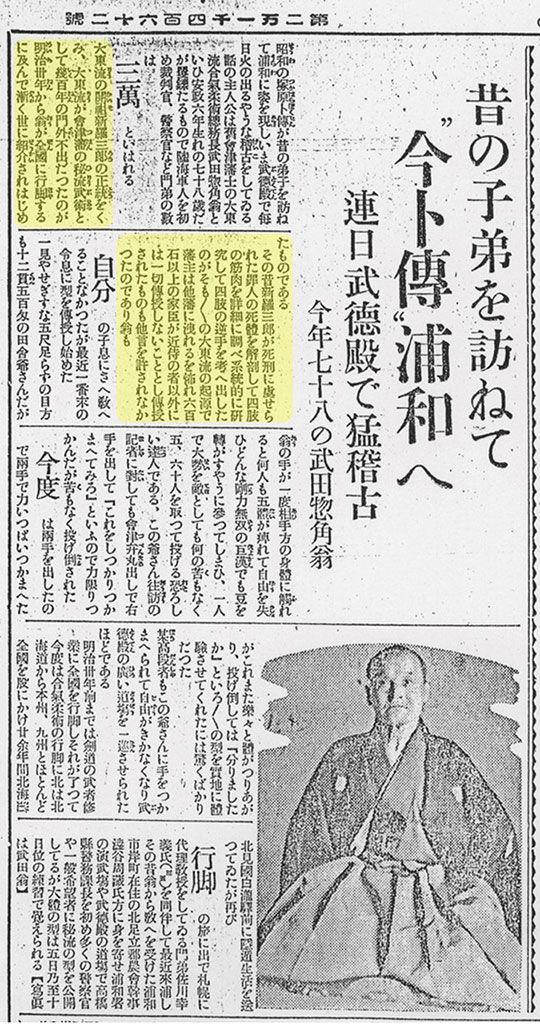 “Nowadays Bokuden” was an article series in Tokyo Nichi Nichi Newspaper named after Tsukahara Bokuden, a famous swordsman of the Sengoku era and founder of Kashima Shinto-ryu Kenjutju. The series introduces Daito-ryu Aikijujutsu through a couple of encounters with Takeda Sokaku and his senior student Sagawa Yukiyoshi. The article above from 1936 titled “Nowadays Bokuden in Urawa” reports on Sokaku’s seminar at the Urawa police station as well as mentions the origin of Daito-ryu highlighted in yellow. For more on the “Nowadays Bokuden” series click here.
“Nowadays Bokuden” was an article series in Tokyo Nichi Nichi Newspaper named after Tsukahara Bokuden, a famous swordsman of the Sengoku era and founder of Kashima Shinto-ryu Kenjutju. The series introduces Daito-ryu Aikijujutsu through a couple of encounters with Takeda Sokaku and his senior student Sagawa Yukiyoshi. The article above from 1936 titled “Nowadays Bokuden in Urawa” reports on Sokaku’s seminar at the Urawa police station as well as mentions the origin of Daito-ryu highlighted in yellow. For more on the “Nowadays Bokuden” series click here.
…The Founder of Daito-ryu is Shinra Saburo. Daito-ryu was transmitted as a secret style of bujutsu in the Aizu clan and has been never disclosed (門外不出), yet the master (Takeda Sokaku) eventually started to teach the art while traveling all over Japan from 1897 (Meiji 30 year). Long ago, Shinra Saburo dissected corps of criminals sentenced to death, examined the muscles of the limbs in detail, and figured out the ways of locking joints (逆手). This is the origin of Daito-ryu in the first place. The feudal lord feared that (Daito-ryu) would leak out to other clans and decided to teach it exclusively to samurai and vassals with an income above 600 koku (1 koku is around 150 kg of rice), and those few who could learn it were not allowed even to talk about it...
Osaka Yoichi - The Recluse Bokuden of Our Times Blindingly Fast Moves of Daito-ryu Aiki
The above-mentioned origin story of Shinra Saburo, however, would make Daito-ryu the oldest Japanese martial art with a history spanning more than 900 years. The article implies that Daito-ryu was a secret style (御留流, Otome-ryu) of the Takeda and later the Aizu clans. On the other hand, the complete absence of any written record of Daito-ryu makes it difficult to believe that a martial art could be successfully transmitted in secret for such a long time, especially considering its unusually extensive technical curriculum. Common examples of Otome-ryu traditions are Yagyu Shinkage-ryu of the Tokugawa clan, Jigen-ryu of the Satsuma clan, or Shosho-ryu of the Nambu clan. Although people outside of those clans were not allowed to learn these martial arts, their existence, and transmission are indeed documented.
Here, I would like to pay attention to the description below of Yoshimitsu’s name within the lineage.
 The evolution of Yoshimitsu’s title in the lineage from the beginning when Sokaku started teaching Daito-ryu till the end of his career. The additional notes describing Yoshimitsu as the founder of the art are marked in red.
The evolution of Yoshimitsu’s title in the lineage from the beginning when Sokaku started teaching Daito-ryu till the end of his career. The additional notes describing Yoshimitsu as the founder of the art are marked in red.
In early scrolls until the 1910s, the note below Yoshimitsu’s name is written as “Shinra Saburo title Kai Genji” (新羅三郎 称甲斐源氏). However, in later scrolls from the 1930s, the following titles were added.
| Year | Title | Source |
|---|---|---|
| 1931 | Jutsu no Shiso (術之始祖, Founder of the Art) |
Horikawa Kodo’s Hiden Mokuroku scroll |
| 1931 | Kaiso (開祖, Founder/Originator) |
Horikawa Kodo’s Aikijujutsu Okugi scroll |
| 1936 | Jujutsu no Shiso (柔術之始祖, Founder of Jujutsu) |
Nakatsu Heizaburo’s Hiden Okugi no Koto certificate |
| 1938 | Daito-ryu Jujutsu no Shiso (大東流柔術之始祖, Founder of Daito-ryu Jujutsu) |
Sagawa Yukiyoshi’s Hiden Okugi no Koto certificate |
Yoshimitsu’s title gradually evolved from the less specific “Founder of the art” to “Founder of Daito-ryu Jujutsu”. In Hisa Takuma's Kaiden no Koto certificate there is even more emphasis put it and Shinra Saburo's name is written in large letters in the middle of the lineage.
 Nakatsu Heizaburo’s Hiden Okugi no Koto and Hisa Takuma's Kaiden no Koto certificate. The mentions Yoshimitsu founder of Daito-ryu and Shinra Saburo Yohimitsu founder of Daito-ryu Jujutsu are highlighted in red.
Nakatsu Heizaburo’s Hiden Okugi no Koto and Hisa Takuma's Kaiden no Koto certificate. The mentions Yoshimitsu founder of Daito-ryu and Shinra Saburo Yohimitsu founder of Daito-ryu Jujutsu are highlighted in red.
Unfortunately, we could not find original data from the 1920's. However, in scrolls issued by Matsuda Toshimi, Yoshimitsu is already mentioned as the founder. Matsuda Toshimi started learning Daito-ryu in 1928 and became kyoju dairi in 1929, thus the change probably happened in the 1920's.
-
 Daito-ryu scroll issued by Kyoju Dairi Matsuda Toshimi in 1938. This scroll is likely to be an exact copy of the one that Sokaku handed out to Matsuda in 1929. The Jutsu no Shiso (術之始祖) title is highlighted in red.
Daito-ryu scroll issued by Kyoju Dairi Matsuda Toshimi in 1938. This scroll is likely to be an exact copy of the one that Sokaku handed out to Matsuda in 1929. The Jutsu no Shiso (術之始祖) title is highlighted in red.
Yoshimitsu, as a samurai lord of the Heian period, is a famous person in Japanese history. Although there are no existing documents supporting that he was the founder of a jujutsu style, in fact, it was very common in Japanese martial arts to claim a famous historical person as the originator of their style with the purpose of making the school look more prestigious and impressive than it really was.
In addition, Yoshimitsu as the founder of Daito-ryu might have been conceivable for the people of Sokaku’s time. Actually, Yoshimitsu’s elder brother is regarded as the originator of Japanese swordsmanship. The origin of this legend is not clear, however, but it appears in Honcho Bugei Shoden (本朝武芸小伝), a book from 1716 introducing the history and legends of Japanese martial arts.
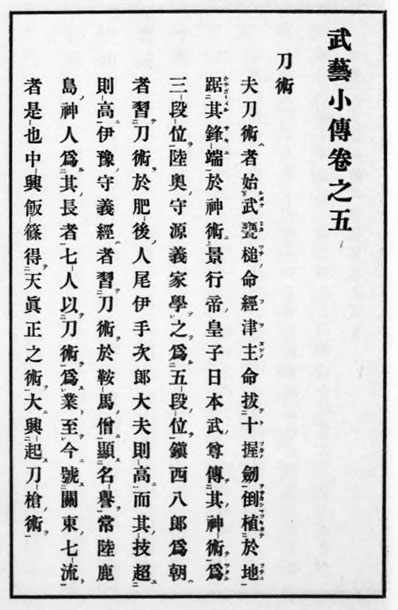 A page from Honcho Bugei Shoden (本朝武芸小伝), written by Hinatsu Shigetaka (1660 - 1732) telling the origin story of Japanese swordsmanship. This book, written in 1716, is known to be the oldest Japanese martial arts history book.
A page from Honcho Bugei Shoden (本朝武芸小伝), written by Hinatsu Shigetaka (1660 - 1732) telling the origin story of Japanese swordsmanship. This book, written in 1716, is known to be the oldest Japanese martial arts history book.
The fifth chapter of this book on swordsmanship (刀術) tells the origin story as follows:
The origin of swordsmanship traces back to the combat between Takemikazuchi and Futsunushi, two deities who stood a sword in the ground upside down and sat on it. This divine art was handed down by Yamato Takeru, a hero of the Japanese creation myth. He established three basic stances, jodan, chudan and gedan kamae and taught this art to (Hachiman Taro) Minamoto no Yoshiie who later added hasso and waki stances, altogether making the five basic stances of the Japanese sword.
Hinatsu Shigetaka - Honcho Bugei Shoden
Sokaku, who in the first place was a swordsman must have heard this legend and it would have been reasonable for him to make Yoshimitsu (younger brother of Yoshiie), who was from his own family lineage, the originator of Daito-ryu.
Note that other Japanese martial arts such as Ogasawara-ryu and Takeda-ryu archery are also traced back to emperor Seiwa and prince Sadasumi and they are said to have been founded by Minamoto no Yoritomo (1147 - 1199), who was the founder and first Shogun of the Kamakura shogunate.Learn more on the Ogasawara-ryu homepage
The lineage continues with Yoshimitsu’s son, Takeda Yoshikiyo, and the members of the Takeda family from Kai Province, present-day Yamanashi prefecture. In the scroll, Yoshikiyo is mentioned as the first son of Yoshimitsu, however, historical records usually describe him as the third son. In Iwabuchi’s scroll from 1899, the Takeda family name is not present; yet it was added soon after putting emphasis on the Takeda family.
 The lineage of Iwafuchi Giemon and Takegawa Gijuro’s Hiden Mokuroku scrolls from 1899 and 1905 respectively. The Takeda family is highlighted in yellow on the right.
The lineage of Iwafuchi Giemon and Takegawa Gijuro’s Hiden Mokuroku scrolls from 1899 and 1905 respectively. The Takeda family is highlighted in yellow on the right.
After a skip of several generations, the lineage mentions Takeda Kunitsugu who moved from Kai to the land of Aizu in 1574 and settled down at a place named Oike.福島県河沼郡会津坂下町大字御池田(旧 河沼郡広瀬村)我が故郷の文化の歩み 1995年 Such an omission or obfuscation of generations is quite unusual in koryu scrolls since the lineage is supposed to prove the unbroken continuation of the transmission.
Oike or as it is called today Oikeda is a tiny village attached to Aizubange city and it is at a distance of around 13 km from the Tsuruga castle in Aizuwakamatsu city. The descendants of Sokaku’s first son Sokatsu, have lived in the same place until today. There is a Buddhist temple, near the Takeda household called Saikoji (西光寺).
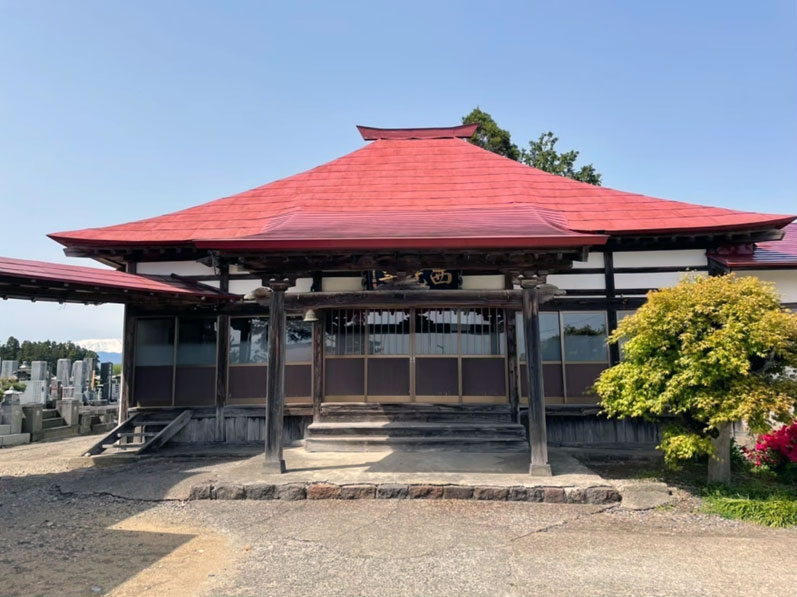 Saikoji temple in Oikeda, Aizubange.
Saikoji temple in Oikeda, Aizubange.
According to the city history book of Aizubange, the temple was built in 1575 by Takeda Kunitsugu and five other individuals. Kunitsugu’s grave can be found in the cemetery attached to the temple further confirming his existence.
After six generations are omitted, we can see the name of Sokaku’s grandfather, Takeda Soemon together with his title name. Since Soemon was his given name, it should be written as Takeda Soemon title Takumi no Kami (武田惣右衛門 称内匠守), however, in the Hiden Mokuroku scrolls, his name is written inversely: Takeda Takumi no Kami title Soemon. This is probably a mistake that was repeatedly copied in all known Hiden Mokuroku scrolls given out by Sokaku. On the other hand, Soemon’s name is written in the correct order in other Daito-ryu scrolls and documents.
At the end of the lineage, Sokaku’s name is written with large characters as being the 35th generation in the lineage. On scrolls and certificates, Sokaku used his martial art name, Takeda Sokaku Minamoto no Masayoshi, emphasizing that the Takeda family is a descendant of the Minamoto family and as it is described in the lineage. His title changed over time as follows:
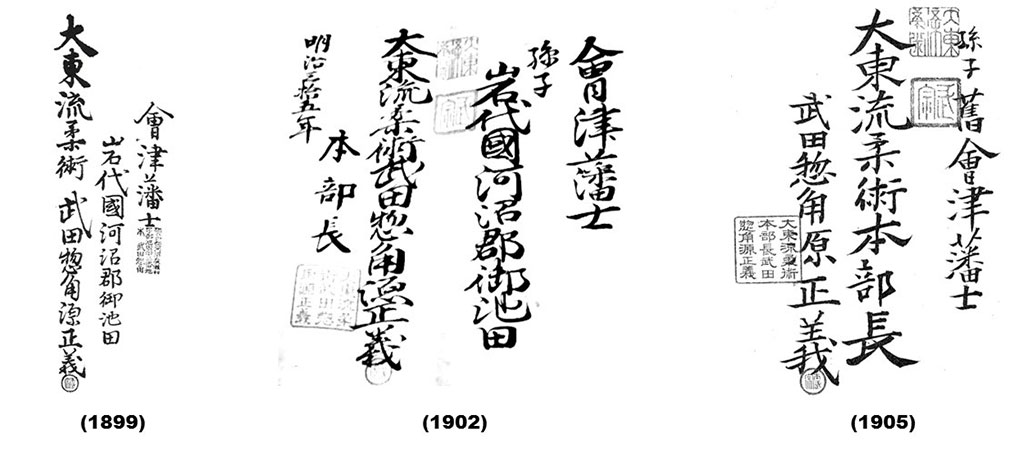 Sokaku’s name and title in early Daito-ryu scrolls.
Sokaku’s name and title in early Daito-ryu scrolls.
In the earliest version of the scroll, Sokaku is described as Aizu Samurai, followed by his address: Iwayo-kuni, Kawanuma-gun, Oikeda, and finally, Daito-ryu Jujutsu Takeda Sokaku Minamoto no Masayoshi. After a few years, in 1902 the title of Hombu-cho is added. In the scroll from 1905, the address is finally omitted and Sokaku’s title is written as former Aizu Samurai, Daito-ryu Jujutsu Hombu-cho. Sokaku kept using this title on Hiden Mokuroku scrolls untill the end of his life.
Although the scroll describes Sokaku as an Aizu samurai, it contradicts the family register from 1876, which instead records the Takeda family as farmers.
 The Takeda Family’s register from 1876 recording the address of the Takeda household, their social status (as farmer), and the family members’ name, age, and relation. Sokaku’s name is written as 武田惣角 (highlighted in red).
The Takeda Family’s register from 1876 recording the address of the Takeda household, their social status (as farmer), and the family members’ name, age, and relation. Sokaku’s name is written as 武田惣角 (highlighted in red).
One possible explanation is that the family was of samurai stock untill the end of the Edo period, but they had to demote their social status to protect the family after the Boshin War.
It is also surprising that Sokaku’s father, Sokichi is not mentioned in the lineage. Soemon died before Sokaku was born in 1853, thus Sokaku could not have learned Daito-ryu from his grandfather. On the other hand, Sokichi passed away in 1906 when Sokaku was 46 years old, so he would have had ample time to teach Sokaku. One popular explanations states that Sokichi being a sumo wrestler, he was too strong (剛力) to succeed in the family traditionHiden Nihon Jujutsu by Matsuda Ryuchi 1978. Actually, in a booklet that Sagawa Yukiyoshi published for prospective students in the mid-1950s, he summarizes the history of Daito-ryu and mentions that:
会津藩士武田内匠守は斯術を会津藩館主保科近悳に相伝し、近悳を故恩師武田惣角先生に継伝したり。
Sagawa Yukiyoshi
Aizu Samurai Takeda Takumi no Kami (Sokaku’s grandfather, Soemon) inherited the art to Hoshina Chikanori, who passed it down to Takeda Sokaku…
Actually, Sagawa updated the lineage in the scrolls he issued, adding Saigo Tanomo's name after Takeda Soemon.
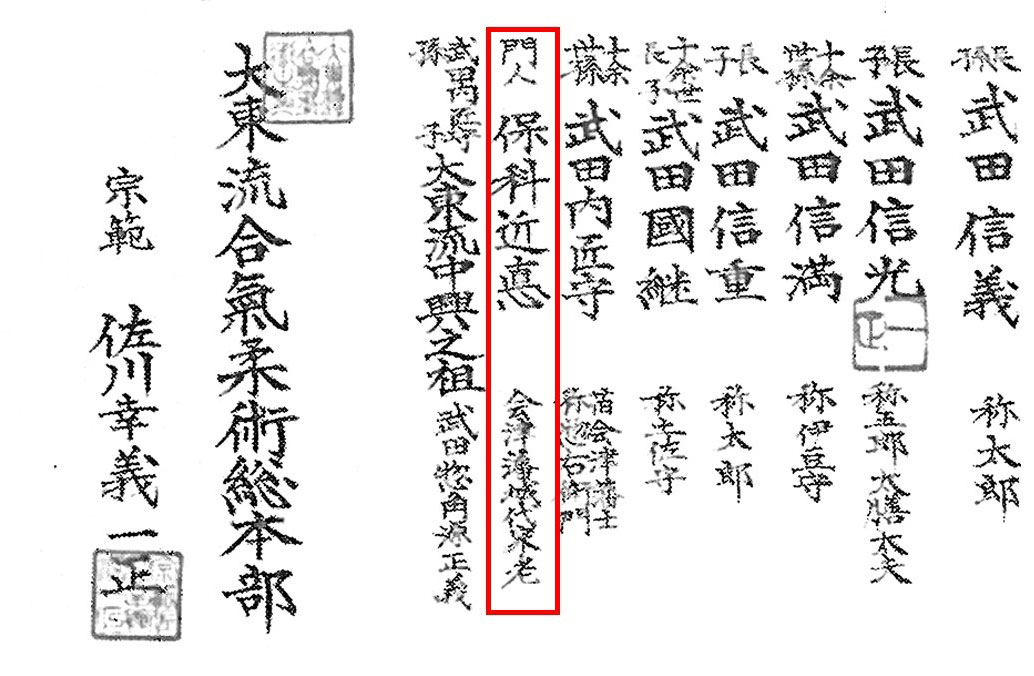 The final segment of a Hiden Mokuroku scroll issued by Sagawa Yukiyhoshi. Saigo Tanomo’s name (Hoshina Chikanori, former Aizu domain chief councilor) is added to the lineage after Takeda (Takumi no Kami) Soemon, Sokaku’s grandfather as his student (門人).
The final segment of a Hiden Mokuroku scroll issued by Sagawa Yukiyhoshi. Saigo Tanomo’s name (Hoshina Chikanori, former Aizu domain chief councilor) is added to the lineage after Takeda (Takumi no Kami) Soemon, Sokaku’s grandfather as his student (門人).
On the contrary, in a newspaper article from 1930for the whole article click here, Sokaku mentions that he learned Daito-ryu directly from his father.
自分が父から受け継ぐ時は、覚えが悪いからといって両手の爪の上にお灸をそえられた
Takeda Sokaku - The Recluse Bokuden of Our Times Blindingly Fast Moves of Daito-ryu Aiki
...when I learned it [Daito-ryu] from my father, he said that I was slow to learn and put moxibustion on the fingernails of both my hands…
Then Sokaku showed his burned fingernails to the reporter.
Actually, Takeda Tokimune in the Daito-ryu Aikibudo Hiden Okugi no Koto certificate, which he awarded to Horikawa Kodo in 1958, added Sokichi’s name to the lineage along with other modifications.
 Horikawa Kodo's Daito-ryu Aiki-budo Hiden Okugi no Koto certificate issued by Takeda Tokimune in 1958. Takeda Sokichi's name as well as the Minamoto family name are marked in red and yellow respectively.
Horikawa Kodo's Daito-ryu Aiki-budo Hiden Okugi no Koto certificate issued by Takeda Tokimune in 1958. Takeda Sokichi's name as well as the Minamoto family name are marked in red and yellow respectively.
As we have seen, in Iwabuchi’s scroll from 1899, only the successor’s given names were written, and the Takeda family name was only added later in the early 1900s. In Tokimune’s lineage, the Minamoto (源) family name is written as well. Here, Minamoto Yoshimitsu is mentioned as the founder of Daito-ryu Budo instead of Daito-ryu Jujutsu. In the middle, after Takeda Kunitsugu, “first son” Takeda Chikara (武田主税) is added, a name that did not appear in the lineage of Sokaku’s scrolls. Since Chikara was added, it follows omitting not six but five generations as Takeda Soemon, “first son” Takeda Sokichi, “first son” Takeda Sokaku, and finally “first son” Takeda Tokimune. With Sokichi in the lineage, the transmission appears to be continuous in the Takeda family. Although Sokaku and Tokimune are mentioned as the first sons, in fact, Sokaku was the second son of Sokichi, and Tokimune was the third son of Sokaku. The description below Sokichi’s name tells that he was the captain of the Aizu domain sumo wrestler troop (during the Boshin war) and his sumo wrestler name was Shirasu (白糸).
According to Sagawa Yukiyohi, Sokaku was great at storytelling and he told three different versions of how he learned the art. Sometimes he told that he learned it from his grandfather, other times from his father, and other times from Chikanori.大東流合気武術史初考 高橋賢 AikiNews No. 124
As we have seen, there are numerous uncertainties around the origin of Daito-ryu. Absence of evidence is not evidence of absence and strictly speaking, this lack of historical evidence does not allow us to entirely dismiss the above-described lineage and origin story. On the other hand, we can’t exclude the possibility that Daito-ryu was created by Sokaku himself, based on his earlier Jujutsu studies. This brings up the question, of what martial arts could serve as the base of Daito-ryu. First place, potential candidates could be jujutsu styles practiced in the Aizu domain such as Mizuno Shinto-ryu, Shinmyo-ryu, and Shinto Seibu-ryu, however, there is an overwhelming number of other theories that exist since Sokaku traveled all over Japan in his twenties and his activity is undocumented. Furthermore, many of the old Jujutsu schools died out after the Meiji restoration making the research even more difficult. One thing is certain, the mysterious nature of Daito-ryu’s origin is one of its appeals and will be a subject of more debate to come.
The lineage and origin story in Aikido
Ueshiba Morihei enrolled as Takeda Sokaku's student in Hokkaido in 1915 and he received the first and second scrolls (Daito-ryu Jujutsu Hiden Mokuroku and Hiden Okugi no Koto) of Daito-ryu Jujutsu in the subsequent year.
Ueshiba received further instruction from Sokaku later in 1922 in Ayabe, Kyoto. After five months of training and interactions between the two men, "Aiki" was officially added to the name of the art. At the same time, Ueshiba became kyoju dairi (教授代理 teaching representative), the first in Daito-ryu Aiki-jujutsu and in addition, he was awarded a certificate "Daito-ryu Aikijujutsu Hiden Okugi no Koto" for the first time. To read more on Daito-ryu certificates click here.
As a student and teaching representative of Sokaku, Ueshiba awarded the first and second scrolls of Daito-ryu to his students.
 Aikijujutsu Hiden Mokuroku scroll issued by Ueshiba Morihei in 1925.
Aikijujutsu Hiden Mokuroku scroll issued by Ueshiba Morihei in 1925.
In this scroll from 1925, Daito-ryu is already omitted and only Aikijujutsu is written to describe the art. The lineage is also abbreviated, after Emperor Seiwa and Prince Sadasumi, 30 generations are skipped to former Aizu Samurai Takeda Sokaku Minamo no Masayoshi followed by monjin (門人, student) Ueshiba Moritaka Minamoto no Seigan (植芝守高源晴眼). Interestingly, Ueshiba also used a Minamoto name that he supposedly received from Sokaku.
It has to be noted that in 1925 Ueshiba had a spiritual experience that he described as follows:
I felt the universe suddenly quake and a golden spirit sprang up from the ground, veiled my body, and changed my body into a golden one. At the same time, my body became light. I was able to understand the whispering of the birds and was aware of the mind of God, the creator of the universe. At that moment I was enlightened: the source of budo [the martial way] is God's love – the spirit of loving protection for all beings ... Budo is not the felling of an opponent by force; nor is it a tool to lead the world to destruction with arms. True Budō is to accept the spirit of the universe, keep the peace of the world, correctly produce, protect and cultivate all beings in nature.Source: Ueshiba, Kisshomaru (1985). Aikido. Tokyo: Hozansha Publications.
It seems that this event changed Ueshiba's view on martial arts. Afterward, he kept changing his art and its name and gradually distanced himself from Sokaku, the hallmarks of which can be found in the scrolls Ueshiba awarded in the pre-war and post-war periods.
 On the left, Takeshita Setsu’s (daughter of Admiral Takeshita Isamu) Aioi Aikijujutsu Hiden Mokuroku from 1928 (more information on this scroll can be found here), awarded by Ueshiba Moritaka student of Takeda Sokaku. On the right, Aikido Hiden Mokuroku from 1960. Although the scroll is structured similarly, we can observe a couple of modifications. For example, item 1 describing Shomen-uchi Ikkyo is replaced with a longer explanation. Unfortunately, the intriguing details are unreadable due to the low resolution of the picture. Also in the text, the original character 敵 (opponent, enemy) is replaced by 人 (person), reflecting the more peaceful nature of Aikido. The awardee is Aikido Doshu Ueshiba Tsunemori eventually without mentioning “student of Takeda Sokaku”.
On the left, Takeshita Setsu’s (daughter of Admiral Takeshita Isamu) Aioi Aikijujutsu Hiden Mokuroku from 1928 (more information on this scroll can be found here), awarded by Ueshiba Moritaka student of Takeda Sokaku. On the right, Aikido Hiden Mokuroku from 1960. Although the scroll is structured similarly, we can observe a couple of modifications. For example, item 1 describing Shomen-uchi Ikkyo is replaced with a longer explanation. Unfortunately, the intriguing details are unreadable due to the low resolution of the picture. Also in the text, the original character 敵 (opponent, enemy) is replaced by 人 (person), reflecting the more peaceful nature of Aikido. The awardee is Aikido Doshu Ueshiba Tsunemori eventually without mentioning “student of Takeda Sokaku”.
In the pre-war period, Ueshiba used various names to describe his art such as Daito-ryu Aikijujutsu, Aikijujutsu, Aioi-ryu Jujutsu, Ueshiba-ryu Jujutsu, Aiki-budo, Tenshin-ryu Aiki-budo, untill 1942 when Aikido was registered as the official name of the art. In addition, in the postwar period Takemusu Aiki (武産合気), Shobu Aiki (聖武合気) were used by Ueshiba Morihei as well.
The fact that Ueshiba handed out Daito-ryu scrolls supports the idea that Daito-ryu served as the technical base of Ueshiba Morihei’s Aikido. On the other hand, the name of his art continuously changed suggesting that his interpretation varied during the time. Simultaneously, Takeda Sokaku and his lineage gradually disappeared from the scrolls. It is interesting, however, that the origin story and Ueshiba's connection to the Takeda family is nonetheless mentioned all the way to an American TV documentary filmed in 1958.
The history of the art (at 8:18) is told as follows:
This science was found by Yoshimitsu Minamoto in the year 1120 and was handed down in his family for generations. It was taken over then by the Takeda family. And here is the legitimate successor of the art, Mr. Moritaka (Morihei) Ueshiba.
Lee Green - Rendez-Vous with Adventure
The mention that the specific date when Daito-ryu was founded is 1120 is a new and interesting piece of information. Minamoto no Yoshimitsu (Shinra Saburo) was born in 1045 and passed away in 1127, suggesting that he was 75 years old when he created Daito-ryu. Here, Ueshiba is mentioned as the legitimate successor of the art passed down in the Takeda family.
Later on, as Aikido evolved into a modern martial art this narrative changed to a more general one, namely that Aikido was created by Ueshiba Morihei as the synthesis of his martial arts experience and religious studies. Ueshiba Kisshomaru - A Life in Aikido: The Biography of Founder Morihei Ueshiba Kodansha International (December 4, 2015)
Summary
According to the lineage described in the document, and likely told by Takeda Sokaku himself, Daito-ryu was founded by Shinra Saburo Minamoto no Yoshimitsu about 900 years ago and passed down in the Takeda family generation after generation. Later it became a secret martial art of the Aizu clan. Unfortunately, however, there is no evidence that would support the existence of Daito-ryu from such an old time. The earliest written mention of Daito-ryu Jujutsu is from Sokaku’s own eimeiroku from 1899. Thus, it is conceivable that the art was created by Sokaku himself based on his earlier Jujutsu studies. This brings up the question of what martial art(s) could have served as the basis of Daito-ryu.
As for Ueshiba Morihei, he awarded Daito-ryu scrolls to his students before the war and also after the war, albeit with slight modifications, which supports the idea that Daito-ryu served as the technical base of Aikido. Accordingly, it seems that Ueshiba occasionally told his students that the art was founded by Shinra Saburo. However, as Aikido evolved into a modern martial art, the story was alterned to a more general one, namely that Aikido was created by Ueshiba Morihei as the synthesis of his martial arts experience and religious studies. The technical content of what Ueshiba taught did not, however change.
Special thanks to Guillaume Erard for his help with the documentation and advice during the redaction of this article. Thank you to Josh Gold from Aikido Journal for letting us use their database. In addition, I would like to express my gratitude to Nomoto Tadashi sensei for the useful discussion and the documents he provided for this research.

